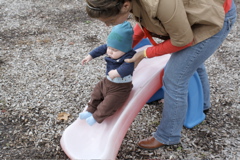Tales of the Dastardly Dryer
It is another rainy day here on the quarter-acre so I thought it would be the perfect opportunity to share a little laundry number crunching with you. More specifically, the cost of running the clothes dryer. I really try to avoid using the dryer at all, opting to hang diapers, clothes, towels, sheets, everything out on the line as much as possible. A typical week includes four or five loads of laundry: two loads of diapers, one of dark clothes, one of light clothes, and towels or sheets. Since we've been getting a lot of rain lately, two of those loads usually end up in the dryer. It got me wondering: how much does it really cost to run our dryer? Our almond-bisque colored Frigidaire dryer, circa 1980, that came with the house?
Lucky for me, this is the kind of stuff Keith does at work so he whipped out a calculator and used this equation to give us an idea how much our dryer costs us each month:
Watts = Amps x Volts
(This information can be found on a tag attached to any electrical appliance).
kWh = (Watts x hours of use) / 1000
You are billed by your electric company for kilowatt hours (kWh). A kilowatt hour is equal to 1000 watts of electricity used for one hour (i.e. Ten-100 watt light bulbs used for one hour).
Cost = kWh x price/kWh (price/kWh can be found on your electric bill)
*This is a basic equation that can be used for any electrical appliance in your home and will provide you with an rough cost to operate an appliance. Calculators can also be found on many websites to help ease the pain for those math-haters out there. Keep in mind, this equation does not account for variations in usage which all appliances have; such as those that use larger amounts of energy at start up than during normal operation.
He based his numbers on two loads a week, totaling 3 hours of drying time, for a four-week month, or eight loads a month. The cost came to $12.79 a month, or about $1.60 per load. That's a serious chunk of change in my (pocket)book. If we didn't utilize the clothes line at all, we would be looking at $25-35 tacked on to our utility bill each month. Ouch!
Our disclaimer here is, as I mentioned, that our dryer is old. We often have to run more than a full cycle, especially if it's diapers we are drying. That's why we calculated each load at an hour and a half. Which got us thinking a little more: we have another, newer dryer in the basement that moved here with us. Would it do any better? Keith was back to the calculator in a flash, only to find that the newer dryer uses more watts, so even if the dry-time were a little shorter, we probably wouldn't be coming out any better. Not too surprising, since all electric dryers tend to use a similar amount of energy - this is the reason Energy Star does not rate clothes dryers.
At any rate, the calculation on the clothesline is pretty simple:
clothesline + wet clothes + sunshine + breeze = free
People are always talking about how they would love to use solar energy in their homes but it's too expensive. A clothesline has to have the biggest return on investment of any solar array.
And here is where we get back on the cloth diaper track. Besides the clothesline making the whole diapering escapade cheaper, the diapers actually end up cleaner. When the diapers come out of the wash, even though they are clean, they tend to have some stains from the poop. If you throw them in the dryer, then you just end up with dried stains. Out on the clothesline, the sun bleaches them out. Not just lightens them. Completely bleaches them away. It is my favorite magic trick, especially since you shouldn't use bleach on diapers because it can be harsh on babies' skin. So diapering is cleaner, cheaper, and greener on the clothesline. Oh how it makes me smile.
As far as washing the diapers, we are still using our homemade laundry soap (we are now on our second batch) and run a cold rinse cycle first and then a hot wash/cold rinse cycle with soap.
Last note on the diapers has to do with diaper cream, or the lack thereof. We had started off using Desitin as needed with the liners, like I mentioned in an earlier post. Then we stopped using the liners. The Desitin was washing out ok, but there was still some residue. I knew there were a few other babies in cloth diapers at the library story time we go to, so I asked what they use. Then I asked their moms because the babies weren't much help. The answer? Lanolin. Pure lanolin. So we picked some up at the health food store (I think you can get it at drug stores too) and have been using it ever since. It seems to do the trick for Bert's bottom, and washes completely out of the diapers. I believe that's what they call a win-win situation. Oh, and it doesn't cost any more than a tube of diaper cream. Win-win-win. And it's all natural. Win-win-never mind, you get it.
 |
Cloth diapers and lanolin,
approved by Bert's bum |


























































